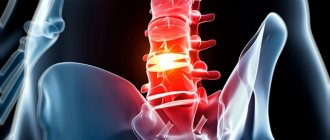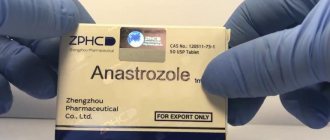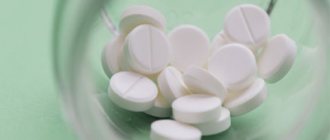- General information
- Effect on the body
- Signs of barbituromania
- Testing for barbiturates
- How long does it stay in the body?
- How long do drug addicts live?
- Analogs
- How to speed up elimination at home
- Detoxification in hospital
- Overdose
- How to recognize
- What to do
- Rehabilitation
- Coding
- Ambulatory treatment
- Working with co-dependents and resocialization
- How to quit on your own
Attention!
Drug use causes irreparable harm to health and poses a danger to life!
General information
Dependence on barbiturates is called barbituromania. These substances are sedatives to which dependence quickly forms. Cases have been described where, due to stressful situations, people used barbiturates for several days to calm down. During this time, they developed dependence and after quitting the drug, withdrawal symptoms occurred.
The drugs are actually very toxic. They depress the nervous system and can cause death due to respiratory arrest.
Barbiturates are not sold without a prescription. In medicine, they are still used as a sedative, for premedication before anesthesia, to relieve anxiety and phobias. Barbiturates do not “heal the heart” or improve conductivity in the brain. On the contrary, abuse of these drugs leads to arrhythmias and dementia.
All drugs from this group are derivatives of barbituric acid, which is synthesized from urea. All barbiturates have approximately the same mechanism of action and have similar effects.
Statistically, more people die from barbiturate overdoses than from heroin or other opiates. This is due to a pronounced dose-dependent effect. That is, a small difference in dose can lead to an overdose. People who suffer from barbituromania never adhere to a strict dosage.
What applies to barbiturates: list
Barbiturate derivatives have a depressant effect on the central nervous system. The therapeutic effect depends on the dose taken - from mild sedation to anesthesia or atonic coma. drugs have the greatest toxic effect
- Amobarbital;
- Barbital;
- Heptobarbital;
- Phenobarbital;
- Cyclobarbital;
- Diallylbarbituric acid.
They cause health problems in the form of acute poisoning from one specific dose. All barbiturates are conventionally divided into groups of short-term, long-acting and long-acting:
- The first include anesthetics, which are administered in preparation for operations for sedation and normalization of blood pressure. The calming effect occurs immediately and lasts 30 minutes. (Thiopental, Hexonal)
- The second group of barbiturates is used for chronic insomnia, atherosclerosis, as well as to lower cholesterol levels and relieve angina. These include: Barbamil, Nembutal. Valid for up to 8 hours.
- The third includes Phenobarbital, Veronal. Use only under medical supervision for epilepsy and convulsive syndrome.
When abused, drug addiction develops. In small doses, barbiturates are included in many sedatives, regulating the autonomic nervous system, and suppressing pain.
Effect on the body
Barbiturates depress the central nervous system. This is due to the effect on the metabolism of gamma aminobutyric acid (GABA), which can slow down or even block some impulse transmissions in neurons of the spinal cord and brain.
Barbiturates are typical nervous system depressants. Their effect is sometimes compared to alcohol intoxication. But this is wrong, since the oppression and toxic effect of barbiturates is more pronounced and poses more danger to life.
The effects are very dependent on the dose and the characteristics of the person’s metabolism. But if you try to get drug intoxicated with the help of these drugs, the following changes appear in the body:
- suppression of thinking processes and memory impairment;
- problem with pronouncing words (slow, incoherent and unclear speech);
- lack of coordination;
- bradycardia (other types of arrhythmia may occur);
- the appearance of bronchospasm and difficulty breathing;
- the appearance of hypersalivation;
- impaired peristalsis, possible diarrhea and loss of fluid through the intestines;
- reaction disorder;
- the appearance of constant drowsiness, lethargy;
- violation of the volitional and emotional sphere;
- drop in libido;
- decreased blood pressure;
- decreased muscle tone;
- slowing down the functioning of the kidneys and liver.
Barbiturates are insidious substances. They can accumulate in the body and cause poisoning, which often causes death due to the potentiation of the effect with each new intake. It is believed that barbiturates can remain in the body for up to 2 weeks from the date of last use.
When the concentration of barbituric acid drugs drops, signs of withdrawal syndrome immediately appear. A person develops dry mouth, becomes anxious, disorders such as compulsive disorder appear, and there may be periodic fasciculations and eye twitching. Sleep becomes restless, it is difficult for a person to get enough sleep and fall asleep.
After 6-10 weeks of regular use, physical dependence on barbiturates may occur. In such cases, the body can no longer function normally without a new dose. Memory problems begin, it is very difficult to remember even simple events. The brain stops thinking logically, and problems begin at work or school. Sometimes, while quitting barbiturates, convulsions, hallucinations, and psychoses appear.
It is believed that irreversible changes in the neurons of the brain occur no earlier than six months after the last dose of the drug.
Consequences of chronic intoxication
With continuous use of drugs for more than 3 weeks, anemia occurs in combination with liver dysfunction and severe headache. Nervous processes are disrupted and slowed down, the following appear:
- speech disorders;
- the clarity of visual perception deteriorates;
- insomnia.
With long-term use - barbituric dementia with decreased ability to judge, impaired attention and memory. Neurological symptoms appear:
- hypomimia;
- tremor;
- decreased tendon reflexes;
- change in handwriting;
- slurred speech.
The drug addict can no longer perform his usual duties. Gross personality changes occur, the pace of brain processes slows down, and social maladjustment develops. Treatment with a gradual reduction in dosage is necessary. Abuse of barbiturates turns patients into weak-minded, but easily excitable subjects.
Signs of barbituromania
Addiction usually appears gradually. Relatives should always pay attention to changes in behavior. It is common for barbiturate addicts to have mood swings. During the period of the drug's effect, they are more talkative, less shy, and easy to make contact with. After the effect ends, they are always aggressive, can be rude or even start fighting, and are looking for money to get a new dose.
Barbiturates have strong effects on the brain. Those who abuse them begin to have problems with speech. They speak poorly, do not remember well what they talked about and what they were asked to do.
Barbiturate addiction also occurs in people who do not know about it. For example, grandparents take Corvalol every day before bed. If they don't do this, they won't be able to sleep well, calm down, or stop worrying.
Barbiturates are inexpensive drugs, but they are often combined with either alcohol or opiates. This leads to rapid spending of money and financial difficulties.
People who abuse pharmaceutical drugs always have bottles of pills and medicine bottles at home. While the drug is taking effect, they do not think about hiding the traces of their addiction, and then they simply forget about it.
Another important episode is that the effect of barbiturates is similar to alcohol intoxication. But there is no smell of alcohol. If a person behaves as if drunk, but there is no smell of alcohol, he is most likely under the influence of barbiturates.
Addiction is equal to drugs
Barbiturates have been used in medicine as a medical drug since the middle of the last century. Then they were used to treat epilepsy, seizures, chronic pain and a number of mental illnesses. Later, this component was introduced into analgesics and simple sedatives, such as valerian tincture. Doctors soon discovered that regular use of drugs containing barbituric acid leads to tolerance. No matter how many barbiturates a person takes, they will not have the expected effect.
A gradual increase in the prescribed dosage provoked the emergence of an addiction similar to a drug. Today, drugs containing barbiturates are used to treat epilepsy. But preference is given to safer benzodiazepines.
Testing for barbiturates
To detect barbiturates in the blood, it is enough to do an express test, which costs from 40 rubles. But this result only shows the fact of drug use. To find out when and what doses a person consumed, it is necessary to conduct a laboratory test.
Rapid tests do not have any legal significance; they are used as a preliminary step, so as not to waste money on expensive laboratory tests.
In cases where a person is specifically tested with rapid tests for barbiturates, it is better to take test tablets. Typically, everyone who abuses pharmaceutical drugs has an addiction and uses other substances. A test for 5 or 10 drugs at once will be able to show which substances a person has used. This is important not only because of the doctor’s interest, but is also necessary to determine the patient’s treatment tactics.
All rapid tests work with enzyme immunoassay or chromatography methods.
Laboratories use more accurate testing, which is based on gas-liquid chromatography or gas chromatography-mass spectrometry. The range of techniques may vary depending on the material and technical base of the laboratory.
More accurate laboratory tests can help determine when a person last used, for how long, and at what doses.
All tests are highly accurate (more than 99%). Testing cannot be cheated. Except in cases where biological fluid is replaced or purposefully spoiled. But usually, tests show these attempts at deception.
Detoxification
3 000 ₽
Calling a narcologist to your home
3 000 ₽
Signs of use
You can understand that your loved one has become addicted by two of his states:
- Intoxication - when a person is in euphoria, relaxed and inhibited, does not immediately hear the question addressed to him, reacts inadequately, slowly, it is difficult for him to concentrate, memory and attention disorders are observed. He wants to be left alone. The euphoria phase ends with deep, long sleep.
- Withdrawal or withdrawal - when the patient experiences a physical and mental need to use, is anxious, excited, he may be paranoid, he tries to leave home to get a drug.
Such repeated emotional swings should alert you. It is necessary to consult a narcologist and undergo a laboratory examination. Barbiturates are determined using the classic test, urine and blood. The doctor will conduct a psychological conversation with the patient, find out the degree of neglect of the situation, types of use - pure or combined, and prescribe therapy.
How long does the drug stay in the body?
- In blood. The drug circulates freely for 24-48 hours. Then it is metabolized in the liver and excreted by the kidneys. Part of the drug is excreted unchanged in the urine.
- In urine. The drug and its metabolites can be detected in the urine up to 2 weeks after the last dose. This is especially important for those who drive. Since even taking medications 3-4 days before a trip can give a positive test result.
- In the nails. It is believed that barbiturate metabolites can be found in the nails within 30-40 days of the last dose. But research is ongoing and inaccurate.
- In saliva. The substance is excreted with saliva within 3-4 days. But it all depends on the length of use and the dose taken. Sometimes there may be differences of 1-2 days.
- In the hair. There is very little data, but most sources indicate that barbiturates and their metabolites can persist in the hair for up to 60 days.
Drugs based on barbituric acid easily accumulate in the body and accumulate in internal organs. Because of this, they are eliminated from the body for a long time using urine, bile, sweat and saliva.
Emergency care for poisoning
Barbiturates in therapeutic quantities are easily eliminated from a healthy body naturally, but their absence causes a condition similar to alcohol syndrome.
The patient experiences tremors of the limbs, nausea, drowsiness, depressed consciousness, and in some cases even vomiting.
However, if too large a dose of barbiturates is taken, they must be removed from the body as soon as possible, since the outcome of poisoning can be very severe - from coma to death.
As with any poisoning, you should start with gastric lavage. This will help get rid of substances that have not yet entered the blood.
The antidote for barbiturate poisoning is Sodium Thiosulfate. In addition, to prevent and prevent oxygen starvation of brain tissue, injections of Bemegride or Corazol are administered.
How long do drug addicts live?
It’s impossible to say for sure. There is a fact that barbiturate addicts who have an additional dependence on other drugs or alcohol do not live longer than 2 years. The second fact suggests that more people die from barbiturate overdose than from opiate overdose.
The drugs accumulate in the body, destroy hepatocytes, nephrons, and have a bad effect on the contractile function of the heart. They destroy most neurons and destroy associative connections in the brain. The main cause of death is respiratory arrest due to the depressant function of barbiturates.
In rare cases, death may occur during withdrawal symptoms. This is due to severe physical dependence and organ failure without a new dose of the drug. Therefore, it is better to fight drug addiction in specialized clinics or drug rehabilitation centers.
Analogs
Barbiturates, as a pharmacological group, are most similar in action to sedatives, alcohol and opiates. Alcohol or opiates are thought to potentiate the effects of barbiturates.
Currently, approximately 10 drugs from the barbiturate group are registered in the Russian Federation. They are mainly sold by prescription and used for anesthesia or sedation. Such drugs include:
- Butalbutal;
- Nembutal;
- Alurat;
- Secobarbital;
- Aprobarbital.
The main representative of the group of barbiturates is phenobarbital. This is what drug addicts abuse most often.
Valocordin and Corvalol are also dangerous. Drugs can cause mental dependence, which can become physical. These drugs contain a small dose of phenobarbital, which causes all the effects of the drug.
Use of barbiturates in medicine
Despite the fact that barbiturates are dangerous for the development of dependence, in some clinical cases their use remains justified and even necessary. The list of medications based on barbiturate acid has today been sharply reduced; drugs can only be purchased with a prescription from a specialist. Main indications for their use:
- stressful situations;
- seizures, convulsions;
- neurological disorders;
- persistent insomnia;
- preparation for anesthesia.
Most often, barbiturates are prescribed for seizures caused by epilepsy. Less commonly, drugs are prescribed to elderly people to achieve a sedative and hypnotic effect. Taking medications before anesthesia enhances the effect of local anesthesia and the effects of analgesics.
On an outpatient basis, drugs are taken in the form of tablets and solutions, in hospital settings - in the form of intravenous and intramuscular injections. Some barbiturate derivatives are found in other medications. For example, phenobarbital is the basis of the popular Corvalol drops.
How to speed up elimination at home
The action of barbiturates lasts from 2 to 24 hours. It all depends on what drug the person is abusing. Depending on this, the effect of detoxification at home will also be different.
To speed up elimination, it is necessary to rinse the stomach. Even if several hours have passed since consumption. To do this, drink up to 2 liters of water and induce a gag reflex. This can be done several times.
After this, activated carbon or other sorbents are taken in an age- or weight-specific dose.
The next step is to drink plenty of compote, water, and tea. But you don’t need to drink 2-3 liters at once, as the water load increases greatly. This should be done gradually, over 5-8 hours. It is important to perform minimal activity: move your arms, legs, walk around the apartment, the street.
All these actions will not lead to a quick cleansing of the body or stopping the action of the substance. But they will help start metabolism and speed up excretion a little.
Detoxification in hospital
This is an important part of treatment, as it is part of the basic course of rehabilitation for barbiturate addiction.
The task of a hospital doctor is to cleanse the body and reduce the toxic effects of barbiturates on the nervous system, kidneys, liver and heart.
The following methods are used in the hospital:
- Infusion therapy. Mainly carried out using colloids, 5% glucose solution, saline solution. If necessary, antioxidants and nootropics are administered along with the infusion.
- Symptomatic treatment and supportive care. Medicines are prescribed to control blood pressure, heart function, and liver function. If necessary, the water-salt balance is adjusted, the patient is saturated with microelements that are lost during the action of the drug.
- Hardware cleaning. Plasmapheresis or hemosorption are used. Those toxic compounds that are not combined with plasma proteins can be removed from the body using hardware purification. These methods improve the functioning of the kidneys and liver, reducing the toxic load on them.
- Forced diuresis. During infusion therapy, diuretics from the group of loop diuretics are given. Due to this, the elimination of toxins is accelerated and the work of the renal nephrons is started.
In the hospital, everyone is prescribed nootropics. These substances are necessary for the restoration of brain cells after long-term inhibition of their work by barbiturates.
All types of drug addiction
Drug addiction treatment
More details
Female, age, beer
Treatment of alcoholism
More details
Overdose
Overdose is the most common cause of death from barbiturates. There are 2 reasons why it occurs:
- accumulation of barbituric acid derivatives in body tissues;
- development of drug tolerance.
Due to accumulation, barbiturates are constantly deposited in the body. The consequence of this is a strong dose-dependent effect. If the patient always took the same amount of the drug and at some point increased the dose by 10%, an overdose may occur.
The development of tolerance is due to the fact that the body tries to fight drugs. Special antibodies and enzymes are produced to break down the drugs. This leads to the fact that addicted people need to constantly increase their dose. When the dose is toxic, an overdose occurs. Some may use several times a day, while others experience an overdose due to one dose of a standard dose.
How to recognize
Usually such people look like drunk people, but they do not smell of alcohol. More than half of these people lose consciousness completely, and their breathing and heartbeat may be impaired.
It happens that drug addicts experience convulsions and fasciculations. There may be profuse vomiting, heavy sweating, and a lot of saliva coming out of the mouth.
The pupils usually do not change in size. The drug addict's breathing is rare and shallow, the pulse is thready and slow.
If you witness such a situation, there is no time to find out what kind of drug the overdose occurred; first aid must be provided.
What to do
Call an ambulance immediately after you are sure that you are not in danger. In cases of barbiturate overdose, the patient's breathing and heartbeat should always be monitored.
If the person is unconscious, begin chest compressions. According to the protocol, first you need to do a heart massage, and not mouth-to-mouth breathing. This is due to the fact that there are still reserves of oxygen in the blood that can be delivered to the brain. And only after 15 presses you need to do mouth-to-mouth breathing. The intensity of pressing should be as follows: 2 times in 1 second.
If the patient is vomiting, be sure to turn the patient's head to the side to prevent aspiration of the vomit. Before performing artificial respiration, make sure that there are no vomit residues in the mouth; if there are any, remove them with a handkerchief or rag wrapped around your finger.
Provide a comfortable environment. If it is cold, cover the patient; if it is hot, undress him and wipe his head with a damp towel. Provide access to fresh air. The ambulance will then be able to provide symptomatic and supportive therapy, and will take the patient to intensive care for further treatment.
Sometimes antidotes are administered, such drugs include: corazol or bemegride. Please note that these medications are ineffective in case of severe overdose; they can only help with minor intoxication.
Rehabilitation
Treatment of barbiturate addiction takes place in 3 stages. Each of them takes place in a hospital, and then treatment in an outpatient setting is possible.
Stages of treatment:
- pharmaceutical and hardware detoxification in a hospital;
- maintenance therapy and symptomatic treatment;
- psychological rehabilitation, work with codependents and resocialization.
In addition, rehabilitation measures include constant monitoring of blood counts. It is important to correct and restore water-salt and mineral metabolism in the body. This allows you to control homeostasis throughout the entire treatment with minimal risks of health problems during withdrawal symptoms.
Literature:
- Voronkov G. L., Vidrenko A. E., Shevchuk I. D. Directory of a psychiatrist. Publishing house "Health" 1990 - 350 p.
- Narcology: national guide/Ed. N. N. Ivanets, I. P. Anokhina, M. A. Vinnikova. - M.: GEOTAR-Media, 2008. - 720 p.
- Zakharchenko M. Yu. Barbiturates, benzodiazepines, anabolic steroids: history of creation, action, analysis. Educational and reference manual / M. Yu. Zakharchenko, I. N. Melnikov, D. V. Kairgaliev; edited by S. Ya. Pichkhidze. —Saratov: KUBiK, 2015 — 189 p.
Ambulatory treatment
The outpatient approach is not effective in treating addiction in the early stages. Patients do not comply with the regimen and do not undergo special psychological training. The conditions of the home environment often become the cause of a breakdown due to the unpreparedness of the patient and his loved ones.
After carrying out the basic therapeutic complexes, outpatient treatment can be used as maintenance therapy.
The problem with home treatment lies in the patient's behavioral patterns. Without preliminary preparation of the volitional sphere, people often simply do not adhere to the doctor’s orders, begin to conflict with loved ones, and again communicate with addicted friends. Under such conditions, neither achieving nor maintaining remission is possible.
Scope of application
Barbiturates were prescribed (in rare cases and are still prescribed) to patients who are susceptible to certain mental disorders, as well as for insomnia.
Very often used in the initial phase when anesthesia is necessary.
As an anticonvulsant, they are indicated for epilepsy, as they can stop an epileptic attack.
Barbiturates have also found their use in veterinary medicine, due to their ability to painlessly carry out euthanasia. Pentobarbital is used for these purposes.
Working with codependents and resocialization
Working with codependents is the penultimate stage before the patient returns home. The essence of this work is the mental preparation of people who have been influenced by the drug addiction of their loved one. They learn new models of behavior and resolution of conflict situations.
Thanks to the trusting relationship between the patient, his relatives and the doctor, an excellent combination is obtained for maintaining the results of treatment and strengthening the volitional sphere of the addict. In such an environment, breakdowns occur less frequently, the patient begins to realize his social significance and responsibility for the condition of his family and friends.
Resocialization is the final stage of recovery of the patient as an individual and a social link. Using this technique, the patient is helped to find and realize himself in everyday life. They look for suitable areas of activity for him, help him develop his interests in order to forget about the craving for drugs. This result is achieved through long-term psychotherapy individually or in group sessions.
The patient himself must understand the harm caused by drugs. He must change his behavior pattern, find his purpose and calling. Often such people become good volunteers who help others fight addiction, or become believers.
Psychological studies show that religious movements are good at supporting remission in addicts.
How to quit on your own
In cases of barbituromania, fighting addiction on your own is very difficult. Without a new dose, patients always experience phobias, anxiety, seizures, sleep disturbances and behavior problems. Toxic damage to neurons affects cognitive functions.
But if a person decides to quit, he must be prepared to experience the terrible psychological craving for the drug. It is important to survive problems with the liver, heart and kidneys (which is not always possible without the help of a doctor).
Patients must completely abstain not only from pharmaceutical drugs, but also from alcohol and other addictive substances.
You need to quit immediately, without putting it off until the next day. Each time you need to convince yourself that even 1 time can be fatal and lead to a breakdown.
It is worth cutting off all ties with people who use drugs and alcohol. If possible, find a hobby or activity to distract yourself from addiction.
Historical facts
The German scientist Adolf Bayer is considered the discoverer of barbituric acid. It was not until 1903 that barbituric acid derivatives began to be marketed as remedies for insomnia and stress.
The first drug to hit the market was Veronal. From 1903 to 1930, the first facts of abuse of barbituric acid derivatives were already recorded. But the lack of an alternative led to the continued use of barbiturates until the 1960s.
After studies and evidence of dependence on barbituric acid derivatives were published, these drugs were abandoned. Now barbiturates are considered illegal drugs, after taking which you cannot drive a car, do work that requires quick reactions and on which the lives of other people depend.











